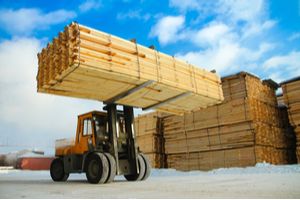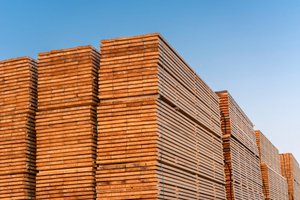In contrast to the characteristics of a decreasing price environment, when market prices rise, higher prices reach developers with a significantly shorter lag. The same reasons that cause big legs in mill costs on the way back down can explain why builders’ lumber costs may rise at the same time as mill prices.
When prices skyrocket, wholesalers get “trigger happy.” During certain periods, their inventory costs are cheap in comparison to cash pricing, so they will estimate at or around current market prices. Wholesalers may confidently buy low and sell high in this atmosphere.

Lumber prices have risen again in the United States over the last month. Since the start of the COVID-19 pandemic, the cost of lumber has been volatile, sharply plunging and unexpectedly spiking during the last two years. Despite a brief drop in pricing earlier this year, the price of lumber has risen steadily throughout February, reaching $1,272 per thousand board feet, the highest price since summer 2021.
According to the Labor Department’s latest producer price index report, softwood lumber prices increased by a staggering 25.4 percent in January alone. Learn more about why wholesale lumber prices have increased so significantly.
What Causes Lumber To Be So Expensive?
The price increases for lumber in 2022 and the two years prior are unprecedented and unparalleled. It is difficult to recall another occasion in recent history when the market has been so volatile. Prices have not yet reached the peak achieved in May 2021, but they are still around three times more expensive than before the pandemic.
A variety of variables are combining to drive up lumber costs and destabilize the marketplace, with a housing boom being one of them.
Bardon summed up the situation: “A number of variables may be contributing to the lumber shortages and price increase. Housing demand is continuing to rise, exerting strain on the distribution chain. The pandemic’s influence on the transportation systems that convey the lumber is still having an impact on the supply chain. The supply chain is still being slowed by a labor shortfall.”

National sawmills have struggled to meet rising demand, and while production has improved since the start of the pandemic, labor shortages continue to stymie production.
The cost of home construction and renovations has risen in tandem with the rise in prices. The National Association of Home Builders estimates that rising lumber prices have boosted home construction expenses by roughly $18,600. The situation has been exacerbated by a recent transportation strike in Canada, as well as an underlying logistical issue.
We now have a logistics problem rather than a scarcity. Many Canadian producers are running out of railcars to keep shipments moving. As a result, the mills have a lot of inventory while the field has very little. The recent steep spike is due to a reduction in log supply across much of Canada and the United States.
Furthermore, the distribution system has been disrupted as a result of tariffs as well as adverse weather conditions. Coastal wildfires in the United States and parts of British Columbia, as well as excessive rains in the Canadian province late the year before, wiping out a number of vital transit routes have exacerbated the problem.
When Will Prices For Lumber Drop?
Wet weather or heavy snowstorms can disrupt the supply chain, both in terms of obtaining raw materials and transporting them to the factory and the lumber buyer. Wildfires can burn down trees or create other problems that make it difficult to retrieve them. It’s understandably difficult to anticipate how the lumber market will grow and whether prices will stabilize or continue to fluctuate in peaks and troughs, but demand will continue to drive prices.
Prices for plywood and lumber will also begin to decrease as demand declines. Most of the people who can benefit from low mortgage rates will eventually have purchased a home. And ultimately, interest rates will increase. The sharp rise in home demand will be over by the end of 2023. Sales of plywood and lumber will then start to decline to more typical levels.

Some business leaders in the wood products industry consider the current demand to be normal, not excessively high. From 1960 to 2010, annual housing starts were an average of 1.5 million units, but the past ten years have fallen short of that average. That justification ignores population increase, which is the main factor influencing housing demand. Population increase during that earlier time period was 1.1 percent annually on average. However, the growth in our population over the last ten years has only been 0.6 percent. The number of households increased by 1.3 million annually between 1960 and 2010. Growth in the previous ten years was barely 1.1 million households on average. Furthermore, due to extremely low immigration, the population rate has decreased even further in recent years. The historic 1.5 million housing starts is plausible as a peak year, not an average, with slower population and household growth.
Prices for wood and plywood normally increase in the spring and decrease by the end of the fall by around 5%. Look for a leveling off this year rather than a drop. For another 2 – 3 years, prices will stay high before declining to more typical levels. Mortgage rates will be a determining factor in the rate of reduction. Homebuilders will eventually pass on the costs to their customers. DIY enthusiasts will have a valid reason to put off starting new projects.
Once demand slows, lumber prices will stabilize. Prices will reduce as logistics improve, but the market will never be able to keep up with increased demand due to logging. Prices will drop as summer approaches, but there is a chance they may rise again if demand increases.
Have Questions? Contact Us Today
To learn more about wholesale lumber prices and options that may be in your business’ best interest, don’ hesitate to reach out to our professional, helpful staff at Curtis Lumber and Plywood today for more details and information.

